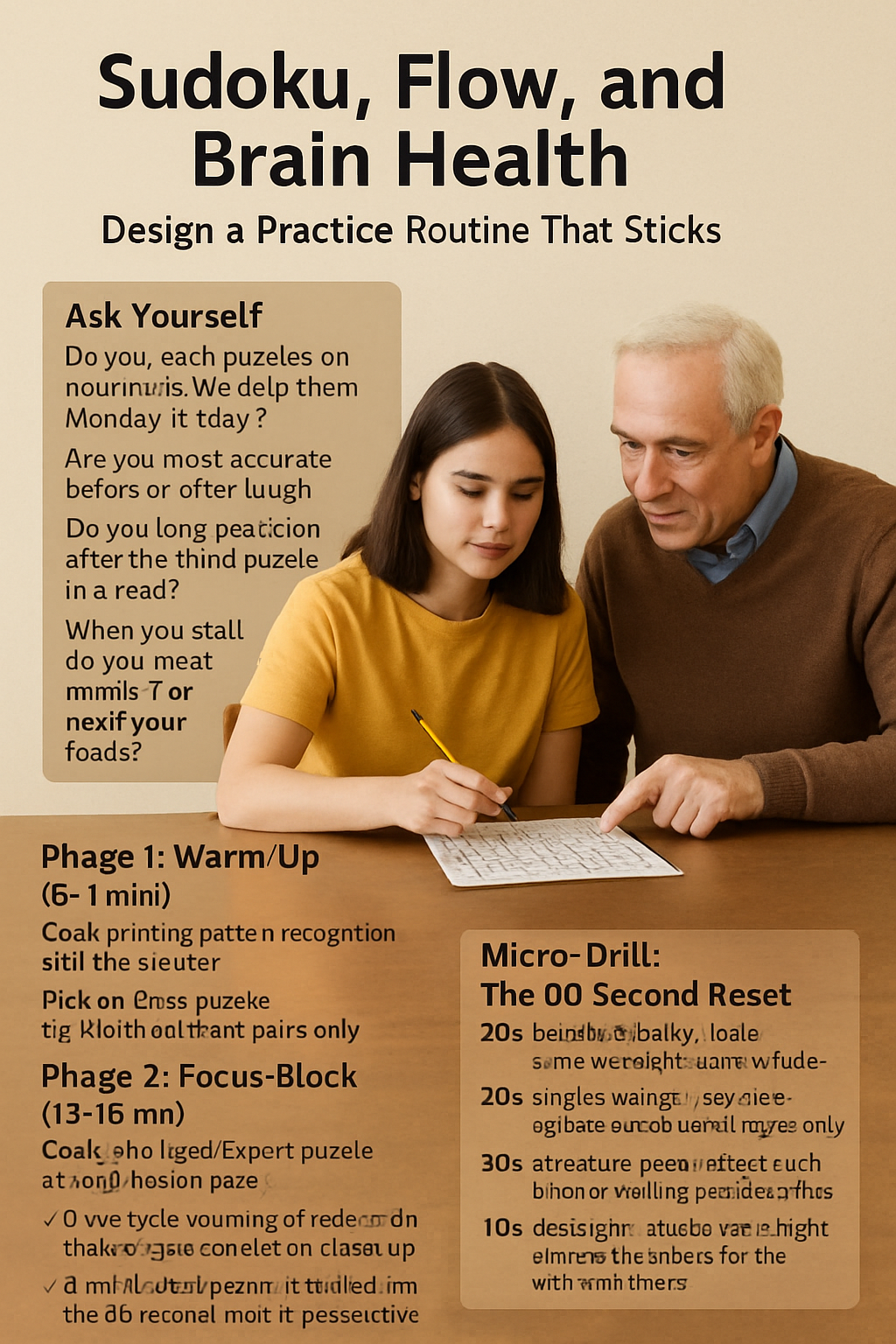
Sudoku, Flow, and Brain Health: Design a Practice Routine That Sticks
Imagine a quiet morning ritual: one warm-up online Sudoku puzzle, one focused challenge, one mellow cooldown. No rushing, no second-guessing—just a steady rhythm that leaves you sharper and calmer. Could routine, not raw talent, be the edge you’re missing?
What We’ll Cover
- A three-phase training plan
- A 90-second reset that dissolves stalls
- A simple analytics sheet you can maintain in under two minutes
- A research-grounded look at why short, regular sessions may support cognitive performance over time
The Science-Backed Case for Short, Consistent Sessions
Across large samples prior to 2024, adults who frequently tackle number puzzles tend to show better reasoning, memory, and processing speed on cognitive tests compared with infrequent puzzle-solvers.
Effect sizes are modest (think steady, compounding gains, not miracles), and studies are mostly correlational. Still, the pattern is consistent: varied difficulty + regular practice beats rare, marathon sessions.
As always, puzzles aren’t medical care, but they are a practical way to keep mental gears engaged.
Ask Yourself
- Do you cram puzzles on weekends but skip them Monday–Friday?
- Are you most accurate before or after lunch?
- Do you lose precision after the third puzzle in a row?
- When you stall, do you push harder—or reset your focus?
The Three-Phase Sudoku Routine
Phase 1: Warm-Up (5–7 minutes)
Goal: prime pattern recognition with low friction.
Pick an Easy puzzle and fill only singles and obvious pairs. Stop before it gets hard. This preserves mental freshness for your main effort.
Phase 2: Focus Block (12–18 minutes)
Goal: one Hard/Expert puzzle at deliberate pace.
- Two-cycle scanning: rows → columns → boxes, then candidates
- Notes discipline: one notation, immediate cleanup after placements
- Checkpoint at 8 minutes: if stalled, run the 90-second reset (below) and continue
Phase 3: Cooldown (3–6 minutes)
Goal: consolidation and calm.
Open a Medium puzzle and play relaxed, or review the key turning point of your focus puzzle.
End with one positive note in your log (e.g., “spotted first X-Wing without hints”).
Micro-Drill: The 90-Second Reset
Use this whenever you feel stuck:
- 20s breath & blink: look away from the grid; slow exhale
- 30s singles sweep: one fast pass for hidden/naked singles only
- 30s structure pass: check each box for pointing pairs and box–line
- 10s decision: choose one subgrid to work exclusively for the next minute
👉 If you want a clean slate right now, start a new puzzle and try the reset mid-solve.
What to Track (and What to Ignore)
- Solve time distribution (median over average): consistency beats rare sprints
- Win rate by time-of-day: find your cognitive “golden hour”
- Streaks without errors: how many correct placements can you chain?
- Focus index: number of >60s stalls per puzzle (lower is better)
❌ Skip vanity metrics (“fastest ever”) unless you’re speed-solving.
✅ You’ll improve faster by reducing stalls and late-game errors than by shaving 10 seconds off a best time.
Your built-in analytics on the performance dashboard can serve as a quick coach after each session.
Mind & Body: Practical Wellbeing Tweaks
- Hydration & light snack before your focus block to smooth energy dips
- Ambient noise or low music if it helps concentration (test, don’t assume)
- Posture & lighting: reduce eye strain so candidate marks stay crisp
Methodology & Research Workflow (Transparent)
- Sourcing: platform analytics (solve times, stalls, win rates) and practitioner logs; no external links included by editorial design
- Evidence base: pre-2024 peer-reviewed work on puzzle engagement and cognition (reasoning, memory, processing speed)
- Interpretation: correlations summarized cautiously; no clinical claims; routine suggestions are behavioral, not medical advice
Summary & Call to Action
A sustainable routine beats sporadic heroics. Warm up to prime recognition, focus to push skill boundaries, cool down to consolidate—and track only what drives learning.
Your solving becomes smoother, your confidence steadier, and the game more enjoyable.
👉 Ready to pilot this routine today? Play Sudoku online free, run the warm-up, and log your first focus index.
In a week, what will your data—and your gut—say about your best time-of-day and ideal session length?

 German
German
 Japanese
Japanese
 Arabic
Arabic
 Spanish
Spanish
 French
French
 Russian
Russian
